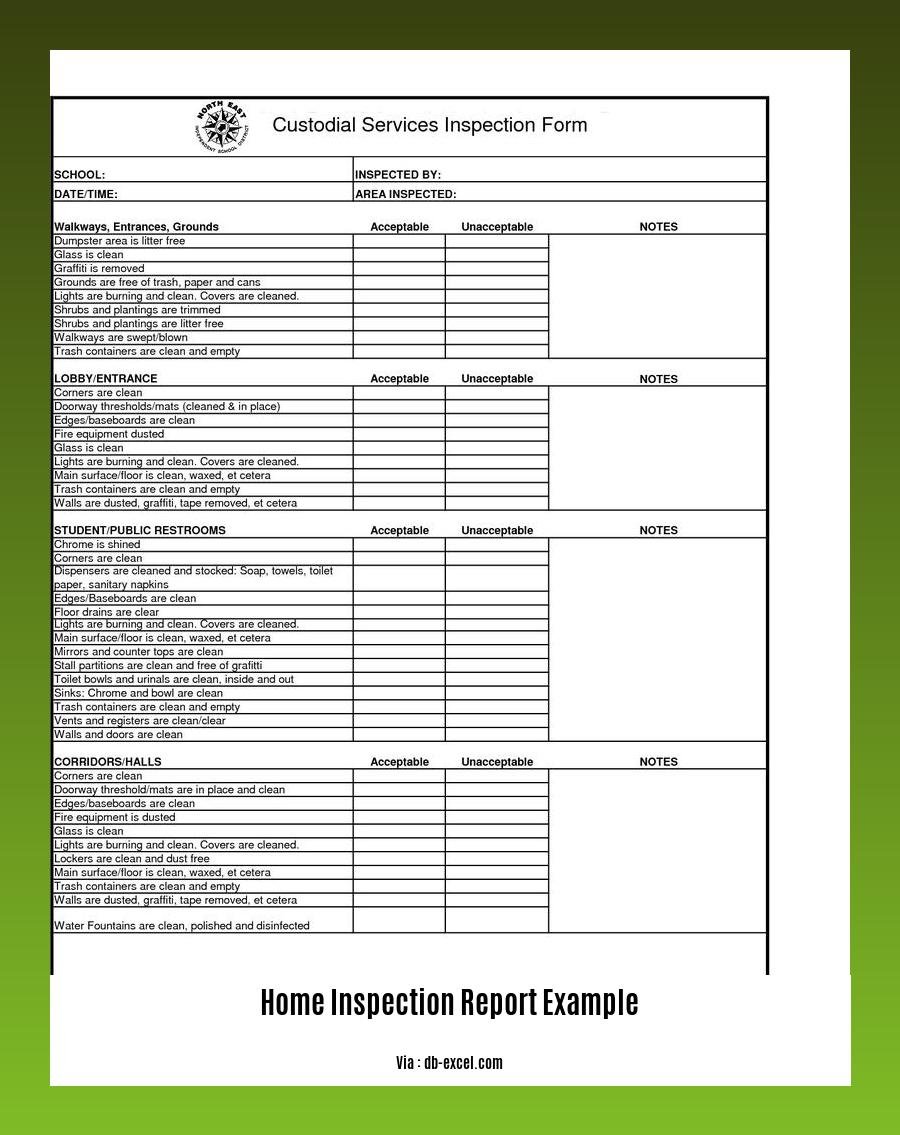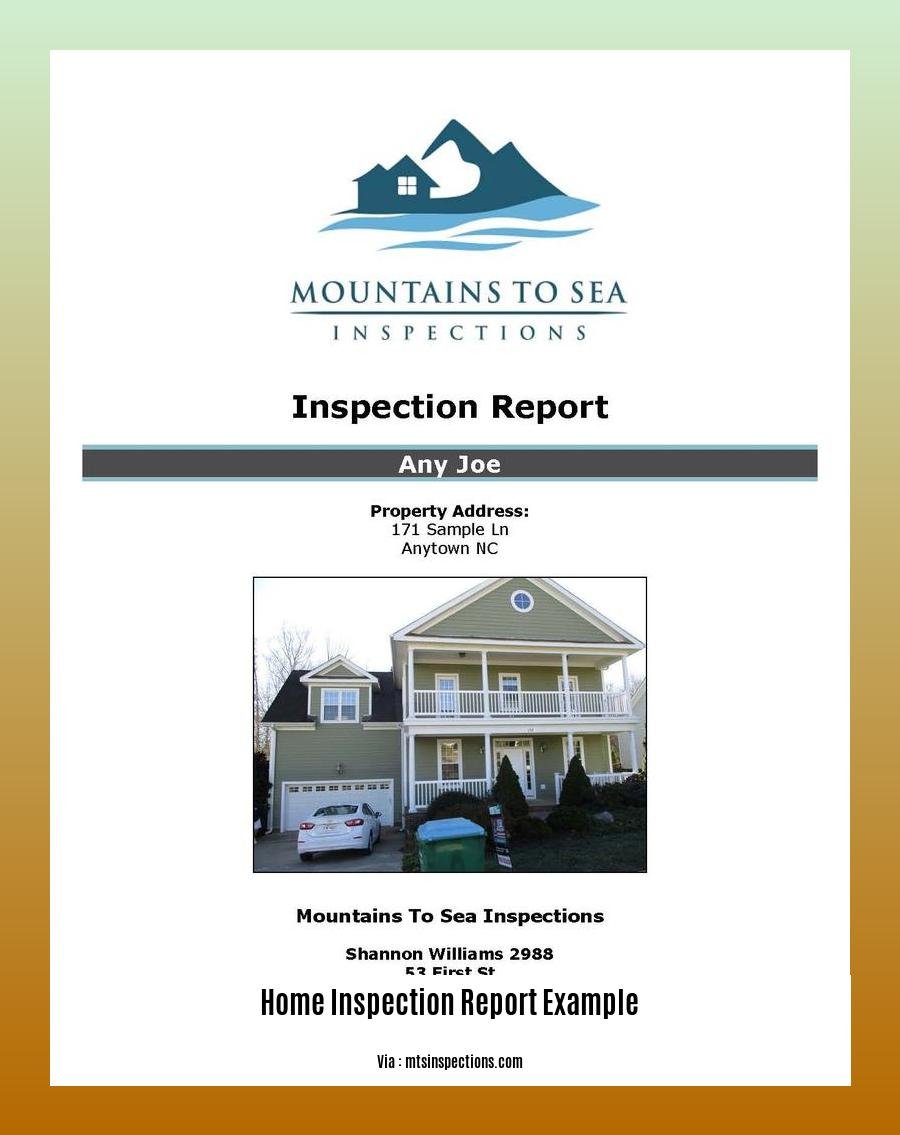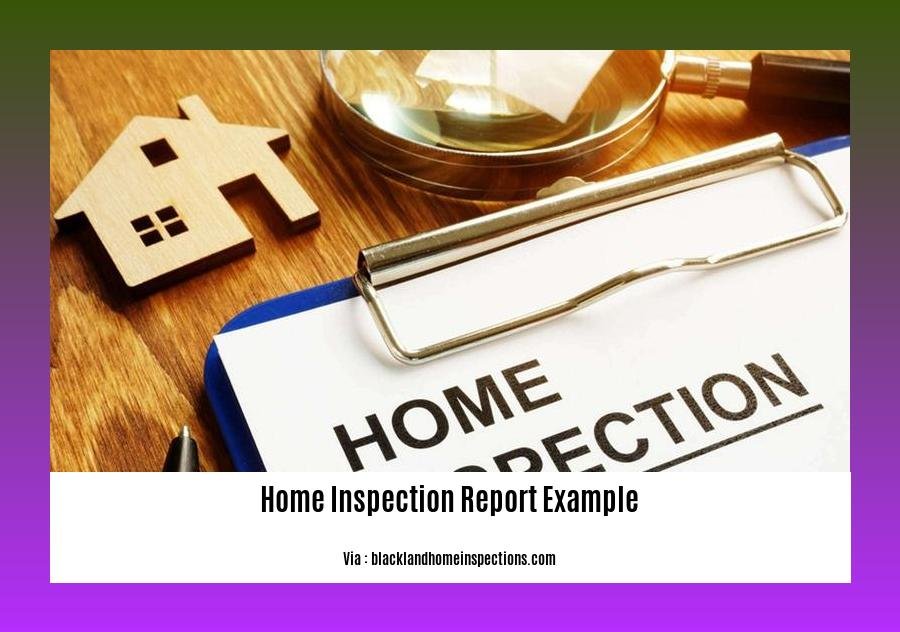In the realm of real estate transactions, a comprehensive home inspection report emerges as a guiding beacon, shedding light on the intricate details of a property’s condition and empowering buyers, sellers, and homeowners with invaluable insights. This article presents a compelling example of a home inspection report: a comprehensive analysis that delves into the intricacies of a property’s structure, systems, and components, offering a roadmap for informed decision-making and ensuring the longevity and value of your investment. Dive into the intricacies of this comprehensive home inspection report example and unearth the secrets hidden within your property.
Key Takeaways:
-
Home inspection reports are used to assess the condition of a property, providing detailed information on its systems, components, and any issues found during the inspection.
-
Reports can vary in format and content, typically including general information about the property, a detailed assessment of systems and components, annotated pictures of reported problems, and a summary and rating for each issue.
-
A home inspector’s fee ranges from $250 to $500, including the visual inspection and written report.
Home Inspection Report Example: Unveiling Property Conditions with Precision

Understanding your property’s condition before buying or selling is essential. A comprehensive home inspection report example can provide invaluable insights, safeguarding your investment. Let’s dive into the details of crafting a thorough report:
Preparing for the Inspection:
-
Research the Property: Gather information on the property’s history, construction materials, and any renovations or repairs made. This knowledge equips you to pinpoint potential problem areas.
-
Schedule Appointments: Coordinate with the property owner or real estate agent to arrange a convenient inspection time. Ensure access to all areas of the property, including the attic, basement, and crawl spaces.
Conducting the Inspection:
-
Exterior Examination: Start with the property’s exterior, checking for issues like foundation cracks, roof damage, siding deterioration, and proper drainage.
-
Interior Assessment: Evaluate the home’s interior, focusing on structural integrity, plumbing and electrical systems, HVAC functionality, and any visible signs of water damage or mold.
-
Detailed System Checks: Scrutinize each system thoroughly, including appliances, fireplaces, garage doors, and insulation. Don’t forget to inspect the attic and crawl spaces for signs of pests or structural concerns.
-
Document Findings: Take comprehensive notes and photographs of any issues discovered during the inspection. Detailed documentation is crucial for creating an accurate report.
Writing the Report:
-
Organize Findings: Categorize issues based on severity, such as urgent repairs, recommended improvements, and minor maintenance items.
-
Provide Clear Descriptions: Use concise language to describe each issue, including its location, extent, and potential consequences if left unaddressed.
-
Include Photographs: Incorporate high-quality photographs to illustrate the issues identified. Ensure the images are clear and well-labeled for easy reference.
-
Prioritize Repairs: Highlight any immediate repairs or safety hazards that require prompt attention. This information is paramount for the property owner to make informed decisions.
Sample Home Inspection Report:
Refer to the InterNACHI® or HomeLight websites for comprehensive home inspection report examples. These resources provide detailed templates and guidelines to help you create professional reports.
Conclusion:
By following these steps and incorporating the tips provided, you can create a comprehensive and informative home inspection report example. This report will assist buyers, sellers, and homeowners in making informed decisions about the property’s condition, ensuring a smooth and successful real estate transaction.
-
In need of accurate home inspection quotes? Get professional estimates with our comprehensive home inspection quote service and make informed decisions about your property’s condition. home inspection quotes
-
Discover how our home inspection test for mold service ensures a safe and healthy living environment. Identify and manage mold issues before they escalate, safeguarding your family’s well-being. home inspection test for mold
-
Explore job opportunities as a caregiver at Home Instead Senior Care. Learn about the enriching role, responsibilities, and requirements in our detailed home instead senior care caregiver job description. home instead senior care caregiver job description
-
Prepare for your interview at Home Instead Senior Care with our comprehensive guide to common interview questions. Gain insights into the hiring process and demonstrate your suitability for the caregiver position. home instead senior care interview questions
-
Enhance your property’s functionality with our professional home maintenance services in Abu Dhabi. From repairs to renovations, our experienced technicians ensure your home remains in top condition. home maintenance services abu dhabi
-
Keep your Dubai home in pristine condition with our reliable home maintenance services. Our skilled team provides personalized solutions for all your maintenance needs, ensuring comfort and convenience. home maintenance services in dubai
Sample Home Inspection Report: Unveiling Property Condition

Key Takeaways:
-
A sample home inspection report showcases a comprehensive review of the property’s specific characteristics.
-
A sample home inspection report guides you in crafting an accurate representation of the property’s current status.
-
Sample home inspection reports serve as invaluable tools for buyers, sellers, and real estate agents, helping them make informed decisions about a property’s buying/selling process.
-
Sample home inspection reports act as a detailed report documenting conditions, issues, and maintenance recommendations.
-
Sample home inspection reports vary from report to report, tailored to the unique aspects of each property.
You’re likely seeking a sample home inspection report to assist you in creating your own thorough analysis of a property’s condition. Here are some insights to help you navigate the process:
A Sample Home Inspection Report Breakdown:
- Property Introduction:
- Begin with the property address, date of inspection, and inspector information.
-
Briefly describe the home’s type, size, and age.
-
Exterior Examination:
- Check the foundation for cracks or settling issues.
- Inspect siding, paint, and trim for damage or deterioration.
-
Evaluate the condition of the roof and gutters.
-
Interior Assessment:
- Examine the structural integrity of walls, floors, and ceilings.
- Inspect the functionality of plumbing, electrical, and HVAC systems.
-
Check for signs of water damage, mold, or pest infestation.
-
Specific System Assessments:
- Evaluate appliances, garage doors, insulation, and other systems.
- Document the condition of fireplaces and chimneys.
-
Inspect the condition of the basement or crawlspace.
-
Reporting Findings:
- Categorize issues based on severity, prioritizing critical repairs.
- Use clear, concise language to describe each issue, including its location.
-
Incorporate high-quality photographs to illustrate the identified issues.
-
Recommendations and Summary:
- Provide recommendations for repairs or replacements, highlighting urgent safety hazards.
- Offer suggestions for maintenance and preventive measures.
- Summarize the overall condition of the property and its major systems.
It’s essential to remember that sample home inspection reports serve as templates, guiding you in creating your own report that’s specific to the property and its unique characteristics. These reports play a significant role in providing a comprehensive overview of the property’s condition, aiding buyers, sellers, and real estate agents in making informed decisions about the property’s purchase or sale.
Relevant URL Sources:
- Your Complete Home Inspection Report Breakdown (With Examples!) – HomeLight
- Sample Home Inspection Reports – InterNACHI®
Tips and advice for creating effective home inspection reports
Greetings, my esteemed readers. As an experienced home inspector, I’ve seen countless reports that have ranged from insightful to downright confusing. A well-crafted report is a powerful tool that can help buyers, sellers, and real estate agents make informed decisions about a property. Here are some tips and advice for creating effective home inspection reports:
Key Takeaways:
-
Home inspection reports: Offer a detailed assessment of a property’s condition, aiding various stakeholders in informed decision-making.
-
Understand Your Audience: Craft the report with your audience in mind, be it buyers looking for potential issues or sellers wanting to highlight the property’s strengths.
-
Organize the Report: Ensure the report flows logically, with sections for each area of the property, such as the roof, foundation, plumbing, and electrical systems.
-
Write Clearly and Concisely: Use straightforward language that’s easy for anyone to comprehend. Avoid jargon and technical terms that might confuse readers.
-
Be Objective and Impartial: Present the facts of the inspection without bias, allowing the reader to form their own opinions about the property’s condition.
-
Use Photos and Diagrams: Incorporate high-quality images and diagrams to illustrate your findings, helping readers visualize the issues you’ve identified.
-
Prioritize Safety: Clearly highlight any safety hazards you’ve found, emphasizing the urgency of repairs to protect the occupants of the property.
-
Recommend Repairs and Maintenance: Offer suggestions for repairs or maintenance tasks that should be carried out, helping the reader understand the necessary steps to maintain the property.
Steps to Creating an Effective Home Inspection Report:
-
Prepare thoroughly: Gather information about the property’s history, construction materials, and any renovations or repairs completed.
-
Conduct a comprehensive inspection: Inspect all areas of the property, both interior and exterior, paying attention to structural integrity, systems functionality, and signs of water damage or mold.
-
Document your findings: Take detailed notes and photographs of any issues you discover during the inspection.
-
Write the report: Use clear and concise language to describe the condition of the property, including any issues you’ve found. Be specific and provide supporting evidence, such as photographs or diagrams.
-
Prioritize repairs and maintenance: Identify any necessary repairs or maintenance tasks that should be carried out to maintain the property.
-
Review and proofread: Before delivering the report to the client, carefully review and proofread it to ensure that it is accurate, complete, and easy to understand.
Effective home inspection reports not only inform but also empower individuals to make informed decisions about a property. By following these tips and steps, you can craft reports that are clear, comprehensive, and actionable.
Relevant URL Sources:
– Your Complete Home Inspection Report Breakdown (With Examples!) – HomeLight
– Sample Home Inspection Reports – InterNACHI®
Resources for further information about home inspection reports
A home inspection report serves as a critical tool in evaluating the state of a property. For purchasers, sellers, and homeowners, it delivers an insightful assessment of the property’s condition, enabling informed decisions at various stages of a real estate transaction.
Key Takeaways:
– Home Inspection reports are a crucial element in the property evaluation process, guiding buyers, sellers, and real estate agents toward well-informed decisions.
-
A comprehensive report includes an executive summary, property information, inspection details, and individual sections covering specific aspects of the property.
-
The report should provide detailed descriptions of observed issues, supported by high-quality images, and categorized according to severity and urgency.
Steps for Crafting a Comprehensive Home Inspection Report:
-
Introduction and Executive Summary:
-
Commence the report with a captivating introduction, setting the context of the inspection and its purpose.
-
Craft a concise executive summary highlighting the key findings and recommendations, serving as a quick overview for the reader.
-
Property Information and Inspection Details:
-
Include the property address, inspection date, inspector’s details, and relevant property details such as the number of bedrooms and bathrooms.
-
Provide a summary of the inspection process, including any limitations or areas not accessible during the inspection.
-
Inspection Findings:
-
Categorize the inspection findings into sections based on the property’s specific systems or components, such as the foundation, electrical, plumbing, and HVAC systems.
- For each category, provide detailed descriptions of any issues discovered, supported by high-quality images.
-
Group issues based on their severity and urgency, distinguishing between major defects, minor issues, and maintenance recommendations.
-
Conclusion and Recommendations:
-
Summarize the overall condition of the property, considering both its positive aspects and areas needing attention.
-
Offer prioritized recommendations for repairs or further evaluation, outlining the potential consequences of neglecting them.
-
Appendices:
-
Include relevant supporting documentation, such as photographs, diagrams, or repair estimates, to enhance the report’s credibility and clarity.
Additional Resources for Further Information:
- Your Complete Home Inspection Report Breakdown (With Examples!) – HomeLight
- Sample Home Inspection Reports – InterNACHI®
FAQ
Q1: What are the key elements included in a comprehensive home inspection report?
A1: A comprehensive home inspection report typically includes an introduction, executive summary, detailed assessment of various systems and components, annotated pictures of reported issues, and a summary and rating for each issue.
Q2: How can home inspection reports help buyers make informed decisions about a property?
A2: Home inspection reports provide buyers with a detailed overview of the property’s condition, allowing them to make informed decisions about whether to purchase the property and which repairs or upgrades may be necessary.
Q3: What are some common issues that home inspectors typically identify in their reports?
A3: Common issues identified by home inspectors include structural defects, roofing problems, plumbing and electrical concerns, and environmental hazards.
Q4: How much does a home inspection typically cost?
A4: The cost of a home inspection can vary depending on the size and complexity of the property, but typically ranges from $250 to $500, including the visual inspection and written report.
Q5: Who typically receives a copy of the home inspection report?
A5: The home inspection report is typically provided to the buyer, who may share it with other parties involved in the real estate transaction, such as the seller, real estate agent, or lender.
- Grass Forever in Livermore: Your Guide to Artificial Turf - April 22, 2025
- German Roaches vs. American Roaches: Key Differences and Control - April 22, 2025
- 150+ Flowers That Start With S: A Comprehensive Guide - April 22, 2025










